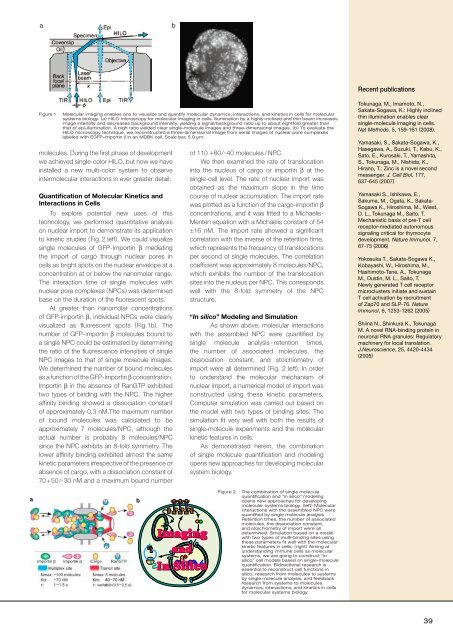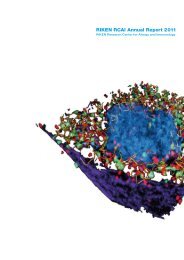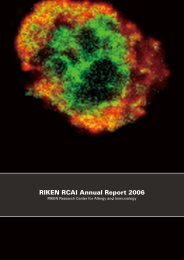in vivo
in vivo
in vivo
You also want an ePaper? Increase the reach of your titles
YUMPU automatically turns print PDFs into web optimized ePapers that Google loves.
a<br />
b<br />
Recent publications<br />
Figure 1<br />
Molecular imag<strong>in</strong>g enables one to visualize and quantify molecular dynamics, <strong>in</strong>teractions, and k<strong>in</strong>etics <strong>in</strong> cells for molecular<br />
systems biology. (a) HILO microscopy for molecular imag<strong>in</strong>g <strong>in</strong> cells. Illum<strong>in</strong>ation by a highly-<strong>in</strong>cl<strong>in</strong>ed and th<strong>in</strong> beam <strong>in</strong>creases<br />
image <strong>in</strong>tensity and decreases background <strong>in</strong>tensity, yield<strong>in</strong>g a signal/background ratio up to about eightfold greater than<br />
that of epi-illum<strong>in</strong>ation. A high ratio yielded clear s<strong>in</strong>gle-molecule images and three-dimensional images. (b) To evaluate the<br />
HILO microscopy technique, we reconstructed a three-dimensional image from serial images of nuclear pore complexes<br />
labeled with EGFP-import<strong>in</strong> β <strong>in</strong> an MDBK cell. Scale bar, 5.0 µm.<br />
molecules. Dur<strong>in</strong>g the first phase of development<br />
we achieved s<strong>in</strong>gle-color HILO, but now we have<br />
<strong>in</strong>stalled a new multi-color system to observe<br />
<strong>in</strong>termolecular <strong>in</strong>teractions <strong>in</strong> ever greater detail.<br />
Quantification of Molecular K<strong>in</strong>etics and<br />
Interactions <strong>in</strong> Cells<br />
To explore potential new uses of this<br />
technology, we performed quantitative analysis<br />
on nuclear import to demonstrate its application<br />
to k<strong>in</strong>etic studies (Fig. 2 left). We could visualize<br />
s<strong>in</strong>gle molecules of GFP-import<strong>in</strong> β mediat<strong>in</strong>g<br />
the import of cargo through nuclear pores <strong>in</strong><br />
cells as bright spots on the nuclear envelope at a<br />
concentration at or below the nanomolar range.<br />
The <strong>in</strong>teraction time of s<strong>in</strong>gle molecules with<br />
nuclear pore complexes (NPCs) was determ<strong>in</strong>ed<br />
base on the duration of the fluorescent spots.<br />
At greater than nanomolar concentrations<br />
of GFP-import<strong>in</strong> β, <strong>in</strong>dividual NPCs were clearly<br />
visualized as fluorescent spots (Fig.1b). The<br />
number of GFP-import<strong>in</strong> β molecules bound to<br />
a s<strong>in</strong>gle NPC could be estimated by determ<strong>in</strong><strong>in</strong>g<br />
the ratio of the fluorescence <strong>in</strong>tensities of s<strong>in</strong>gle<br />
NPC images to that of s<strong>in</strong>gle molecule images.<br />
We determ<strong>in</strong>ed the number of bound molecules<br />
as a function of the GFP-import<strong>in</strong> β concentration.<br />
Import<strong>in</strong> β <strong>in</strong> the absence of RanGTP exhibited<br />
two types of b<strong>in</strong>d<strong>in</strong>g with the NPC. The higher<br />
aff<strong>in</strong>ity b<strong>in</strong>d<strong>in</strong>g showed a dissociation constant<br />
of approximately 0.3 nM.The maximum number<br />
of bound molecules was calculated to be<br />
approximately 7 molecules/NPC, although the<br />
actual number is probably 8 molecules/NPC<br />
s<strong>in</strong>ce the NPC exhibits an 8-fold symmetry. The<br />
lower aff<strong>in</strong>ity b<strong>in</strong>d<strong>in</strong>g exhibited almost the same<br />
k<strong>in</strong>etic parameters irrespective of the presence or<br />
absence of cargo, with a dissociation constant of<br />
70+50/-30 nM and a maximum bound number<br />
of 110 +60/-40 molecules / NPC.<br />
We then exam<strong>in</strong>ed the rate of translocation<br />
<strong>in</strong>to the nucleus of cargo or import<strong>in</strong> β at the<br />
s<strong>in</strong>gle-cell level. The rate of nuclear import was<br />
obta<strong>in</strong>ed as the maximum slope <strong>in</strong> the time<br />
course of nuclear accumulation. The import rate<br />
was plotted as a function of the cargo-import<strong>in</strong> β<br />
concentrations, and it was fitted to a Michaelis-<br />
Menten equation with a Michaelis constant of 54<br />
±16 nM. The import rate showed a significant<br />
correlation with the <strong>in</strong>verse of the retention time,<br />
which represents the frequency of translocations<br />
per second of s<strong>in</strong>gle molecules. The correlation<br />
coefficient was approximately 8 molecules/NPC,<br />
which exhibits the number of the translocation<br />
sites <strong>in</strong>to the nucleus per NPC. This corresponds<br />
well with the 8-fold symmetry of the NPC<br />
structure.<br />
“In silico” Model<strong>in</strong>g and Simulation<br />
As shown above, molecular <strong>in</strong>teractions<br />
with the assembled NPC were quantified by<br />
s<strong>in</strong>gle molecule analysis - retention times,<br />
the number of associated molecules, the<br />
dissociation constant, and stoichiometry of<br />
import were all determ<strong>in</strong>ed (Fig. 2 left). In order<br />
to understand the molecular mechanism of<br />
nuclear import, a numerical model of import was<br />
constructed us<strong>in</strong>g these k<strong>in</strong>etic parameters.<br />
Computer simulation was carried out based on<br />
the model with two types of b<strong>in</strong>d<strong>in</strong>g sites. The<br />
simulation fit very well with both the results of<br />
s<strong>in</strong>gle-molecule experiments and the molecular<br />
k<strong>in</strong>etic features <strong>in</strong> cells.<br />
As demonstrated here<strong>in</strong>, the comb<strong>in</strong>ation<br />
of s<strong>in</strong>gle molecule quantification and model<strong>in</strong>g<br />
opens new approaches for develop<strong>in</strong>g molecular<br />
system biology.<br />
Tokunaga, M., Imamoto, N.,<br />
Sakata-Sogawa, K.: Highly <strong>in</strong>cl<strong>in</strong>ed<br />
th<strong>in</strong> illum<strong>in</strong>ation enables clear<br />
s<strong>in</strong>gle-molecule imag<strong>in</strong>g <strong>in</strong> cells.<br />
Nat Methods. 5, 159-161 (2008).<br />
Yamasaki, S., Sakata-Sogawa, K.,<br />
Hasegawa, A., Suzuki, T., Kabu, K.,<br />
Sato, E., Kurosaki, T., Yamashita,<br />
S., Tokunaga, M., Nishida, K.,<br />
Hirano, T.: Z<strong>in</strong>c is a novel second<br />
messenger. J. Cell Biol. 177,<br />
637-645 (2007)<br />
Yamasaki S., Ishikawa, E.,<br />
Sakuma, M., Ogata, K., Sakata-<br />
Sogawa K., Hiroshima, M., Wiest,<br />
D. L., Tokunaga M., Saito, T.<br />
Mechanistic basis of pre-T cell<br />
receptor-mediated autonomous<br />
signal<strong>in</strong>g critical for thymocyte<br />
development. Nature Immunol. 7,<br />
67-75 (2006)<br />
Yokosuka T., Sakata-Sogawa K.,<br />
Kobayashi, W., Hiroshima, M.,<br />
Hashimoto-Tane, A., Tokunaga<br />
M., Dust<strong>in</strong>, M. L., Saito, T.<br />
Newly generated T cell receptor<br />
microclusters <strong>in</strong>itiate and susta<strong>in</strong><br />
T cell activation by recruitment<br />
of Zap70 and SLP-76. Nature<br />
Immunol. 6, 1253-1262 (2005)<br />
Shi<strong>in</strong>a N., Sh<strong>in</strong>kura K., Tokunaga<br />
M. A novel RNA-b<strong>in</strong>d<strong>in</strong>g prote<strong>in</strong> <strong>in</strong><br />
neuronal RNA granules: Regulatory<br />
mach<strong>in</strong>ery for local translation.<br />
J.Neuroscience, 25, 4420-4434<br />
(2005)<br />
a<br />
b<br />
Imag<strong>in</strong>g<br />
and<br />
In Silico<br />
Figure 2<br />
The comb<strong>in</strong>ation of s<strong>in</strong>gle molecule<br />
quantification and “<strong>in</strong> silico” model<strong>in</strong>g<br />
opens new approaches for develop<strong>in</strong>g<br />
molecular systems biology. (left) Molecular<br />
<strong>in</strong>teractions with the assembled NPC were<br />
quantified by s<strong>in</strong>gle molecule analysis.<br />
Retention times, the number of associated<br />
molecules, the dissociation constant,<br />
and stoichiometry of import were all<br />
determ<strong>in</strong>ed. Simulation based on a model<br />
with two types of multi-b<strong>in</strong>d<strong>in</strong>g sites us<strong>in</strong>g<br />
these parameters fit well with the molecular<br />
k<strong>in</strong>etic features <strong>in</strong> cells. (right) Aim<strong>in</strong>g at<br />
understand<strong>in</strong>g immune cells as molecular<br />
systems, we are go<strong>in</strong>g to construct “<strong>in</strong><br />
silico” cell models based on s<strong>in</strong>gle-molecule<br />
quantification. Bidirectional research is<br />
essential to reconstruct cell functions <strong>in</strong><br />
silico; research from molecules to systems<br />
by s<strong>in</strong>gle molecule analysis, and feedback<br />
research from systems to molecules.<br />
dynamics, <strong>in</strong>teractions, and k<strong>in</strong>etics <strong>in</strong> cells<br />
for molecular systems biology.<br />
39





